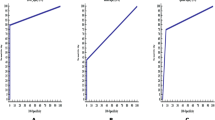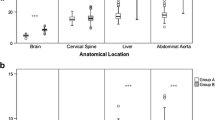Abstract
This pictorial essay shows low-dose multi-detector computed tomography (MDCT) findings of blunt hepatobiliary trauma, and describes the indications and protocol for MDCT. Given the universal usage of MDCT in assessing the liver in blunt abdominal trauma, reduction of patient dose is essential. The new l0se MDCT protocol presented here can achieve up to 50% dose reduction while maintaining diagnostic image quality and thus facilitate dose sensitive patient management. Our institution’s blunt hepatobiliary MDCT imaging algorithm can help determine which patients require operative therapy. Injury to the liver is graded on various schemes, one being the Organ Injury Scale devised by the American Association for the Surgery of Trauma classification based on the extension of the lesion and bleeding.




















Similar content being viewed by others
References
Christe A, Ross S, Oesterhelweg L, Spendlove D, Bolliger S, Vock P, Thali MJ (2009) Abdominal trauma—sensitivity and specificity of postmortem noncontrast imaging findings compared with autopsy findings. J Trauma 66(5):1302–7
Matthes G, Stengel D, Seifert J et al (2003) Blunt liver injuries in polytrauma: results from a cohort study with the regular use of whole-body helical computed tomography. World J Surg 27:1124–1130
Shuman WP (1997) CT of blunt abdominal trauma in adults. Radiology 205(2):297–306
Beal SL (1990) Fatal hepatic hemorrhage: an unresolved problem in the management of complex liver injuries. J Trauma 30:163–9
Pachter HL, Spencer FC, Hofstetter SR, Liang HG, Coppa GF (1992) Significant trends in the treatment of hepatic trauma: experience with 411 injuries. Ann Surg 215:492–500
Ochsner MG, Knudson MM, Pachter HL et al (2000) Significance of minimal or no intraperitoneal fluid visible on CT scan associated with blunt liver and splenic injuries: a multicenter analysis. J Trauma 49(3):505–10
Romano L, Giovine S, Guidi G, Tortora G, Cinque T, Romano S (2004) Hepatic trauma: CT findings and considerations based on our experience in emergency diagnostic imaging. Eur J Radiol 50:59–66
Sampson MA, Colquhoun KBM, Hennessy NLM (2006) Computed tomography whole body imaging in multi-trauma: 7 years experience. Clinical Radiology 61:365–369
Tas F, Ceran C, Atalar MH, Bulut S, Selbes B, Isik AO (2004) The efficacy of ultrasonography in hemodynamically stable children with blunt abdominal trauma: a prospective comparison with computed tomography. Eur J Radiol 51:91–96
Shanmuganathan K, Mirvis SE (1995) CT evaluation of the liver with acute blunt trauma. Crit Rev Diagn Imaging 36:73–113
Kinnunen J, Kivioja A, Poussa K, Laasonen EM (1994) Emergency CT in blunt abdominal trauma of multiple injury patients. Acta Radiol 35:319–22
Petridis A, Pilavaki M, Vafiadis E, Palladas P, Finitsis S, Drevelegas A (1999) CT of hemodynamically unstable abdominal trauma. Eur Radiol 9:250–255
Molina DK, Nichols JJ, DiMaio VJ (2007) The sensitivity of computed tomography (CT) scans in detecting trauma: are CT scans reliable enough for courtroom testimony? J Trauma 63:625–629
Moore EE, Cogbill TH, Jurkovich GJ, Shackford SR, Malangoni MA, Champion HR (1995) Organ injury scaling: spleen and liver (1994 revision). J Trauma 38(3):323–324
Helling TS, Ward MR, Balon J (2009) Is the grading of liver injuries a useful clinical tool in the initial management of blunt trauma patients? Eur J Trauma Emerg Surg 35:95–101
MacLean A, Durso A, Cohn SM et al (2005) A clinically relevant liver injury grading system by CT, preliminary report. Emerg Radiol 12:34–7
Cohn S, Arango J, Myers J et al (2009) Computed tomography grading systems poorly predict the need for intervention after spleen and liver injuries. Am Surg 75(2):133–139
Shanmuganathan K, Mirvis SE (1998) CT scan evaluation of blunt hepatic trauma. Radiol Clin North Am 36:399–411
Yoon W, Jeong YY, Kim JK, Seo JJ, Lim HS, Shin SS et al (2005) CT in blunt liver trauma. Radiographics 25:87–104
Savolaine ER, Grecos GP, Howard J, White P (1985) Evolution of CT findings in hepatic hematoma. J Comput Assist Tomogr 9:1090–1096
Shanmuganathan K, Mirvis SE, Sover ER (1993) Value of contrast-enhanced CT in detecting active hemorrhage in patients with blunt abdominal or pelvic trauma. AJR Am J Roentgenol 161:65–69
Cogbill TH, Moore EE, Jurkovich GJ et al (1988) Severe hepatic trauma: a multicenter experience with 1,335 liver injuries. J Trauma 28:1433–1438
Knudson MM, Lim RC, Oakes DD et al (1990) Nonoperative management of blunt liver injuries in adults: the need for continued surveillance. J Trauma 30:1494–1500
Goffette PP, Laterre PF (2002) Traumatic injuries: imaging and intervention in post-traumatic complications (delayed intervention). Eur Radiol 12:994–1021
Cywes S, Bass DH, Rode H et al (1991) Blunt liver trauma in children. Injury 22:310–314
Eng RH, Tecson-Tumang F, Corrado ML (1981) Blunt trauma and liver abscess. Am J Gastroenterol 76:252–255
Author information
Authors and Affiliations
Corresponding author
Rights and permissions
About this article
Cite this article
Eftekhari, A., Albuali, A.A., Keer, D. et al. Low-dose MDCT findings of blunt hepatobiliary trauma. Emerg Radiol 18, 235–247 (2011). https://doi.org/10.1007/s10140-011-0938-7
Received:
Accepted:
Published:
Issue Date:
DOI: https://doi.org/10.1007/s10140-011-0938-7




